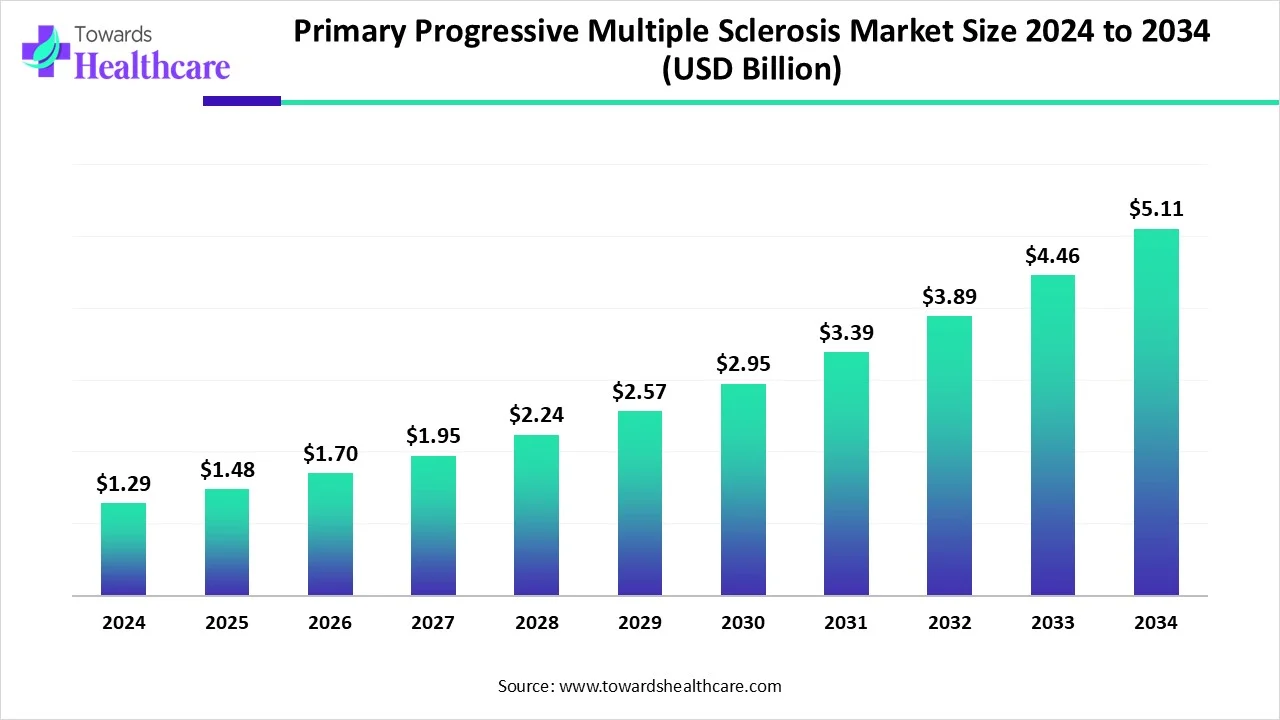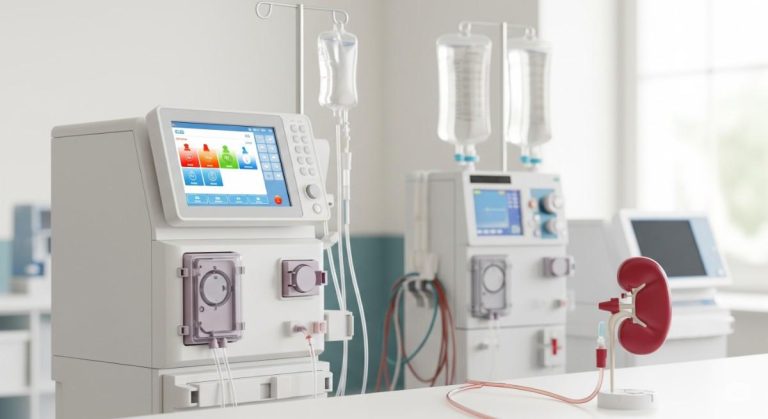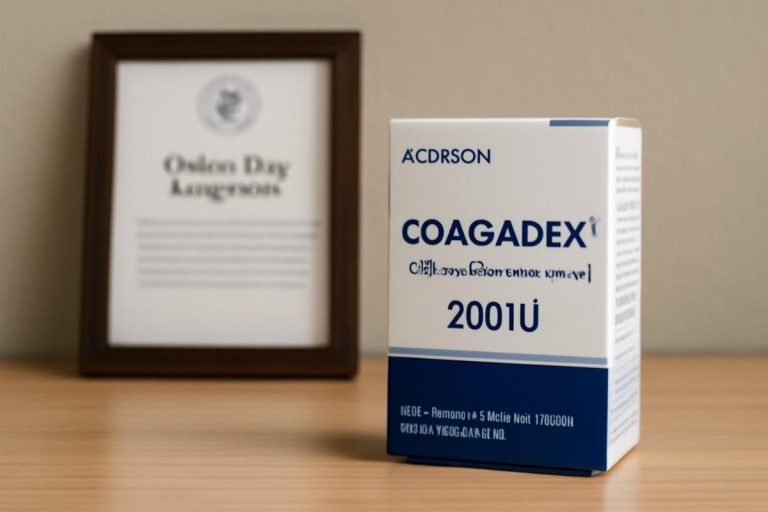
The landscape of Primary Progressive Multiple Sclerosis (PPMS) is on the brink of a transformative decade. With innovative research, strategic funding, and advanced treatment strategies, the PPMS market is projected to experience significant growth from USD 1.29 billion in 2024 to USD 5.11 billion by 2034, achieving a compelling CAGR of 14.84%.

Let’s dive into the key trends, developments, and dynamics shaping this vital sector of neurological healthcare.
Market Overview: A Glimpse into 2024 and Beyond
-
Market Size in 2024: USD 1.29 billion
-
Forecasted Market Size by 2034: USD 5.11 billion
-
Growth Rate: 14.84% CAGR (2025–2034)
Invest in Our Premium Strategic Solution: https://www.towardshealthcare.com/download-databook/5727
Geographic Insights:
-
North America leads the market in 2024, attributed to robust R&D infrastructure and high healthcare expenditure.
-
Asia Pacific is expected to register the fastest growth, driven by improving healthcare access and growing awareness of MS disorders.
Trends Shaping the PPMS Market
1. Regulatory Advancements
-
In July 2025, the Pharmaceutical Benefits Advisory Committee (PBAC) will assess the addition of subcutaneous ocrelizumab to the PBS in Australia, making treatment more affordable and accessible.
2. Strategic Research Commitments
-
The National Multiple Sclerosis Society committed $18.1 million in April 2025 toward its Pathways to Cures roadmap, supporting 16 new research grants and 28 early-career fellowships.
3. Regulatory Acceleration for New Treatments
-
The FDA is reviewing tolebrutinib for treatment of non-relapsing SPMS, with the submission backed by strong Phase III data from the HERCULES and GEMINI trials.
Get All the Details in Our Solutions – Access Report Preview: https://www.towardshealthcare.com/download-sample/5727
AI’s Growing Influence in PPMS Care
Artificial Intelligence is playing an increasingly critical role in the diagnosis and management of PPMS. With applications ranging from pattern recognition in diagnostic imaging to predictive analytics for disease progression, AI is revolutionizing how clinicians understand and treat PPMS.
AI-driven tools offer enhanced detection of subtle changes in MRI scans, allowing earlier interventions and better personalized care plans. This tech-driven advancement is a key enabler of market growth.
Market Dynamics
🔹 Driver: Adoption of Multimodal Treatment Approaches
Healthcare providers are moving toward integrative care models that combine physical therapy, medication, and dietary support. These personalized plans improve symptom control and patient quality of life, boosting market expansion.
🔹 Restraint: High Treatment Costs
The average annual cost per patient is estimated at $88,487, with prescription medications making up more than half. These high costs remain a significant hurdle to wider treatment access.
🔹 Opportunity: Immunomodulatory Drug Approvals
Recent advances and approvals in immunomodulatory therapies for PPMS are opening up new treatment avenues. Clinical trials are currently exploring innovative concepts, building a robust pipeline for future therapies.
If you have any questions, please feel free to contact us at sales@towardshealthcare.com
Segmental Insights
✅ Approved Drugs Lead the Market
Approved drugs held the lion’s share of the market in 2024. These therapies, rigorously reviewed for safety and efficacy, are the backbone of PPMS treatment today.
🚀 Pipeline Drugs Promise Future Growth
Still in development, pipeline drugs show significant promise. Their role in enhancing efficacy, targeting new pathways, and reducing side effects is attracting investor and regulatory attention.
🏪 Retail Pharmacies Remain Dominant
Retail pharmacies offer convenient, holistic care with pharmacist consultations and easy medication access, making them the dominant distribution channel in 2024.
📦 E-Commerce Set to Surge
The e-commerce segment is gaining momentum due to its cost-effectiveness, long-term prescription models, and accessibility—especially valuable for patients in remote or underserved areas.
Regional Spotlight: Europe’s Rising Momentum
Over 700,000 individuals in Europe are affected by MS. The region is seeing rapid innovation across telemedicine, health apps, AI, and VR in healthcare. In December 2023, the International Progressive MS Alliance announced €4.6 million in funding for key initiatives to accelerate treatment development for progressive MS.
What Industry Leaders Are Saying
“Fenebrutinib is potent, extremely selective, and the only reversible BTK inhibitor in Phase III trials for MS,”
— Levi Garraway, M.D., Ph.D., Roche CMO, May 2025
This statement reflects the industry’s focus on more precise, targeted therapies with better outcomes and fewer side effects.
Recent Developments Worth Noting
-
April 2025: Immunic, Inc. announced promising data from its Phase 2 CALLIPER trial involving vidofludimus calcium (IMU-838), a new approach targeting chronic inflammation in MS.
-
March 2025: AdventHealth Neuroscience Institute began enrolling patients in a Phase Ib trial for IDP-023, targeting both primary and non-active secondary progressive MS.
Final Thoughts
The Primary Progressive Multiple Sclerosis market is set for robust growth, fueled by technological integration, supportive policy changes, and groundbreaking research. From AI-powered diagnostics to next-gen immunotherapies, the PPMS sector is not just growing—it’s evolving in unprecedented ways.
This is an exciting time for stakeholders across the board—patients, researchers, pharmaceutical companies, and healthcare providers—as we move closer to improved care and potentially curative therapies for PPMS.
Source : https://www.towardshealthcare.com/insights/primary-progressive-multiple-sclerosis-market-sizing






